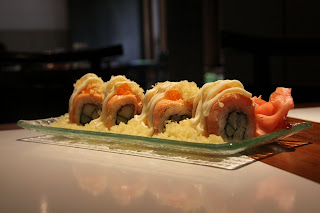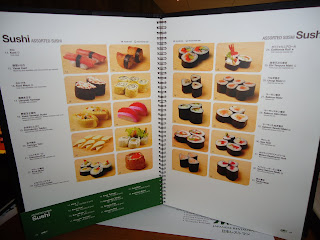
Sep 29, 2010
Sep 28, 2010
After the visit...
That is my impression after visiting the Midori Restaurant. It was better than what I have expected! Basically, thanks to the visit, I’ve gained my knowledge about the Japanese culture! Moreover, we had free lunch offered by the restaurant and all the food were oh-so-good... Great, now I’m hungry again.
First of all, I learned about the basic Japanese etiquette. Seen any Japanese movies? If so, you will realize that the Japanese people are likely to bow most of the times. Now that is called ojigi. It could be a form of greeting, or to show your apology. We also learned about amairu, which is basically the feeling of respect. And shieza is the etiquette for sitting on a tatami. When it comes to the etiquettes in eating, those are the toughest ones. Seriously! You’ve got various ways to use the chopsticks, various ways to hold a bowl AND it depends on what kind of bowl is it (gohan, etc.), and you are also required to pour any type of drink in precision. We also learned about some basic greetings in Japanese, which I honestly already knew because I’ve been studying the Japanese language individually. Then, we discovered how to make sushi, tenpura moriawase and happosai. And the best part was, we got to eat them! For free! I can’t tell you guys just how satisfied I was – especially gastronomically.
See? I told you Japanese dining is an educational dining experience! ;D
Well, gochisousama deshita! Hontou ni arigatou gozaimasu, Midori Restaurant!
Midori Restaurant
- Ojigi, is bowing in two cases: when greeting someone or when apologizing. When bowing, males put their arms on their sides and females cross their arms. When greeting someone, you should bow 45 degrees. When apologizing, you should bow 90 degrees until you are forgiven!
- Shieza, explains how to sit on the tatami properly. Males should sit cross-legged, while females must sit with their knees folded under their thighs or with their legs on one side
Then came the exciting part! We were given recipes, then the chef demonstrated how to make California Roll (a classic!), Salmon Crispy Roll (soooooo yummy), Tenpura and Japanese vegetable stir-fry (which name I happen to forgot....) It turns out that making sushi is quite simple, but you need to master the rolling technique so that the sushi doesn't fall apart when you cut it (you would also need a super-sharp knife too to cut the roll easier... and you must have good sushi rice too).
Then.... we ate!!! Gastronomically, we are extremely satisfied. This is a great trip -- it was very informative and we were all satisfied :)
Thank you, Midori! <3
The Long-Awaited Visit... Yatta!
...do you or do you not?
Oh well, never mind. Anyway, I've always loved Japanese food. It's even number 1 on my "favorite type of food" list. Actually, I started off by hating Japanese food. God, I can't believe how foolish I was to loathe such a heavenly type of cuisine! My father was the one who introduced me to the delicacy. He gave me ikura sashimi, or "fish eggs", and it was my first-ever Japanese dish. At first, I thought it was the weirdest thing ever to be created for man kind to digest. Moreover, it was all slimy and...orange. But, it was so strange that it ended up tasting so good! So, strange things aren't always bad, are they? Ah, yes. Alas, Japanese food opened my eyes and my heart to accept strange, weird & extraordinary things into my life. :D
Therefore, I expect to eat more of this healthy-and-delicious-at-the-same-time cuisine at Midori Restaurant. In addition, I also expect this visit to upgrade my knowledge about Japanese culture, tradition and etiquette, because in fact Japanese dining is a truly educational dining experience, really!
Oh, and I have one more thing to say... yatta!
Future Trip to Midori
Who doesn't know Sushi? One of the most popular dish of Japan. I think, almost everybody in the world knows what Sushi is and have seen or even taste sushi.
Other than sushi, Japan has a lot more famous dishes like Ramen, miso soup, udon, and many others which I can't really remember right now. Anyways, we're going on a field trip to this Japanese restaurant located just a little bit far from the school and it's a very nice restaurant. I've been there before and I think that restaurant is a suitable place for us all to learn on making these Japanese dishes.
I'm hoping
Here's an interesting fact about Japanese food: not all food are well-cooked.
And they actually taste good. How amazing :)
Even if they're not cooked, they're actually healthy for the body and doesn't make you fat (for those people on weight reducing process).
Just by thinking about it, my stomach growls (seriously) and I expect to get the data that I want from visiting that restaurant.
Japanese Cuisine
I am familiar with sushi, in fact, it has become one of my favorite food. I have once tried to make sushi at home, but it failed mostly because I had no rice vinegar. I'd love to know more about making sushi because it's not just about making food, sushi-making is art too. I would also love to learn about how to process raw fish so that it is safe to eat. I want to learn how to cut the sushi roll in perfect precision, making the sushi look neat as soon as it arrives on your table. I would also want to know how wasabi is made. I would also like to know Japanese eating etiquette.
Behind traditional food, there is always an interesting culture!
Sep 27, 2010
Japan's cuisine
Japanese cuisine is an interesting cuisine for me. It makes me want to know how do they make the sushi and sashimi because from what I know most of them are raw. When I go to a Japanese restaurant I want to see how can they make their dishes, how do they cut it, how can they make the rolls and how can they make it to stay in shape until the foods are delivered to all the tables. Not only that but I also want to know why do they serve most of their dishes cold not warm.
Japanese food is kind of tricky for me because like I said before some of them are raw, then how do they kill the germs that are in the meat and also how do they store the fish so it can stay fresh? Not only that I also want to know how can they make crab shell into a dish without hurting the person who is eating it because as we all know, crab shells are hard and they usually use this weird green sauce mixed with soy sauce to eat sushi and sashimi.
Personally I don’t really like Japanese food because most of them are raw and cold, I never liked to eat something cold. So I hope after my visit, I will be able and want to eat Japanese food.
Sep 23, 2010
Midori Japanese Restaurant - I wonder what?
A Trip to the Land of Japan ...
In my mind, Japanese food is unique and delicate on the tongue. With the simplicity of just rice, fish and some traditional spices, Japanese food can also be quite surprising. I really enjoy Japanese food, how it can make me so full even though the portions seem small (or sometimes, the portions are huge). I know some people who don't enjoy or don't even dare eat Japanese food (specifically Sushi) because it is known for being raw and fresh, but I suppose eating Japanese food as a child helps me get over that.
I've heard that the process of making Japanese food is quite complex even though the result seems very simple, I'm hoping to see if that statement will be proving right or not. I'm also hoping that I get to try a different variety of Japanese food, because there is always something new.
So basically I'm hoping that I learn a lot (and eat a lot) when we go to visit Midori, I'm really looking forward to this trip.
- Nadira
Sep 3, 2010
Japan - The Heian Period
Hey y’all... So as you know (you do?), weeks ago I was given an assignment to make a presentation about THE HEIAN PERIOD. Sounds pretty... stiff, eh? BUT as an excellent geographist (yeah right), I’ve tried to make my presentation clear enough – like, crystal clear. Before I show you that, I’m gonna give you guys a brief explanation about what THE HEIAN PERIOD really is first-hand:
Did you know that Kyoto was where THE HEIAN PERIOD originally occured? Well, back then, after the Nara period, the capital city of Japan was sort of moved to Heian-kyo (which is Kyoto now). At that time, it wasn’t the emperor who was in charge of ruling the place; it was a noble family called the FUJIWARA CLAN, and this clan is just pure rich and powerful.So, they took over the emperor’s place and gained absolute control. The emperor and his court didn’t have so much political authority, so they filled their time by developing court ceremonies and just doing more arts... Before long, the court officials were already artistic. They implemented and applied arts to everything they do, making them more artistic (and romantic) everyday. THE HEIAN PERIOD is the period where Japanese arts was at its peak. So basically, THE HEIAN PERIOD was famous for its remarkable arts.
...and there’s still more! You guys could just check out my presentation, it has all the other information about THE HEIAN PERIOD. So there you go, people!
Japan - A New Era
Japan - Drift to War
Japan - Drift to War



























